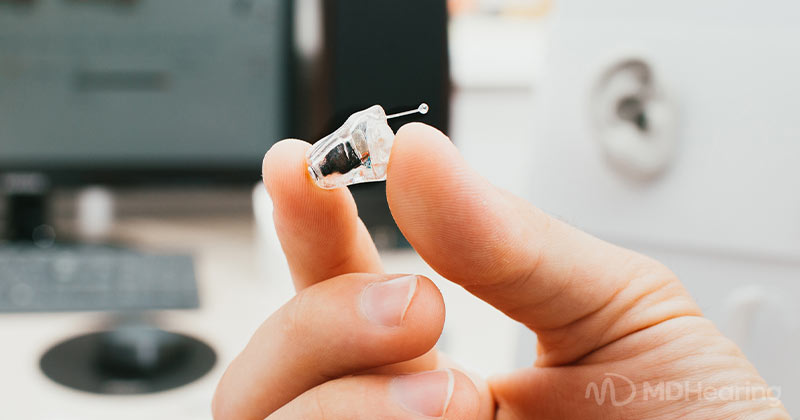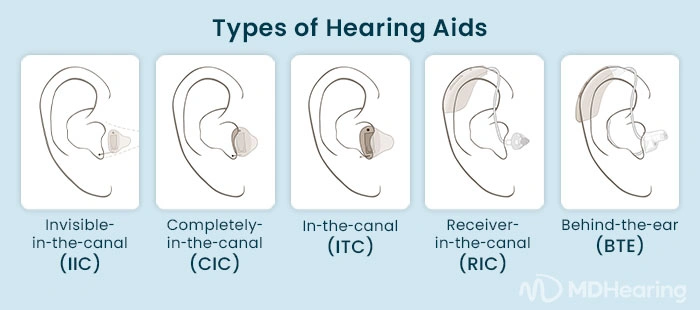Are you in need of hearing aids, but concerned about the bulky look of them? Perhaps you’d prefer a more discreet option for managing your hearing health. If so, invisible hearing aids might be the ideal solution for you.
Invisible hearing aids are the smallest hearing aid available on the market today. They are extremely discreet, but that doesn’t mean they are for everyone. In this article, you’ll learn how invisible hearing aids stack up against other types on the market. We'll explore their unique benefits and potential drawbacks to help you determine if they’re the right choice for your hearing needs.
What Is an Invisible Hearing Aid?
True to their name, invisible hearing aids are virtually undetectable to anyone but the wearer. Also known as Invisible-in-the-Canal (IIC) hearing aids, these devices sit deep inside your ear canal, which is ideal for those looking for discretion.
Invisible Hearing Aids vs. Other Hearing Aid Styles
Invisible-in-the-Canal (IIC) Hearing Aids
As mentioned above, IIC hearing aids are the most discreet hearing aid style, worn deep inside the ear canal with no external tubes or wires. They are often custom-fit and utilize a small pull-out cord for removal. Someone would have to look extremely close to see an IIC hearing aid in your ear.
Because IIC hearing aids utilize the ear's natural shape and sit closest to the eardrum, they offer a more natural listening experience with good sound quality. Their snug fit also helps to reduce issues such as wind noise and feedback, which can sometimes occur with larger hearing aid styles.
It’s important to note that these devices may not be suitable for everyone. They are ideal for mild to moderate hearing loss, but if your hearing loss is severe, they likely cannot provide enough amplification. Factors such as the size and shape of the ear canal can also influence candidacy for IIC hearing aids. Because they’re so small, they often do not come with manual controls to adjust the settings based on the noise in your surrounding environment. Their limited size also means smaller batteries with a shorter lifespan.
Lastly, some people don't care for the feeling of the device in their ear canal, as it can cause a "plugged up" effect.
Completely-in-the-Canal (CIC) Hearing Aids
CIC hearing aids were the smallest hearing aids available before the IIC was introduced. Like IIC hearing aids, CICs are very discreet and sit inside the ear canal, but they don’t fit quite as deep as IIC hearing aids. They are still virtually invisible and would only be seen if someone were looking closely at your ear canal.
While slightly easier to use than IIC hearing aids, the small size of CIC hearing aids means they can suffer from the same drawbacks as IICs: shorter battery life, small buttons/dexterity issues, and not enough amplification for severe or profound hearing loss.
In-the-Canal (ITC) and In-the-Ear (ITE) Hearing Aids
ITC hearing aids and ITE hearing aids are also worn inside the ear with no external tubes or wires. However, unlike the styles discussed above, these hearing aids are larger, giving you more control but making them less discreet. ITC hearing aids sit at the opening of your ear canal (rather than deep inside) and ITE hearing aids sit in the bowl of your outer ear.
The added size allows for a longer battery life, more user-friendly controls, better technology, and may be able to assist more severe hearing loss.
Behind-the-Ear Styles
There are a couple behind-the-ear styles: BTEs (behind-the-ear) and RICs (receiver-in-canal). Both BTEs and RICs sit behind the ear, connecting to the ear canal with a tube/wire and tip, but they differ in the location of the receiver.
The receiver of a BTE is in the body of the hearing aid (behind your ear), with sound traveling through clear tubing. The receiver of a RIC is separate from the hearing aid body and sits in the tip inside your ear canal. Wired tubing connects the receiver to the hearing aid.
These styles are more visible than IICs or CICs, however they can still be quite discreet, especially if you have long hair or larger ears. Behind-the-ear styles can manage any kind of hearing loss from mild to severe. They have better battery life, volume and environment controls, and above-average sound quality.
For more information on the different types of hearing aids, read our Types of Hearing Aids blog.
The Benefits of Invisible Hearing Aids
Invisible to Anyone but You
The main reason someone might choose an invisible hearing aid is the look (or lack thereof) they provide. If you are self-conscious about wearing hearing aids, and you have mild to moderate hearing loss, invisible options may be the choice for you.
However, never let aesthetics get in the way of your health. Hearing loss is a serious health concern that should not go untreated. If you need hearing aids that are larger than IICs, choose the solution that will meet your hearing needs. There are plenty of other models that are surprisingly discreet.
Deep Fit Provides Natural Sound Quality
Because they sit so deep and snugly in your ear canal, IICs preserve the natural way sound interacts with the shape of your ear. If you’re using hearing aids for the first time, the natural sound quality makes it easier to adjust.
The larger the size and the more space a hearing aid takes up in your ear, the more plugged up your ear canal may feel. It’s similar to how you might feel wearing earplugs. This results in the occlusion effect, where voices sound hollow, echoey, and booming. Invisible hearing aids reduce the occlusion effect by sitting deeper in the ear, resulting in less internal vibration.
Disadvantages of Invisible Hearing Aids
Not Suitable for Those With Severe Hearing Loss
Invisible hearing aids are not powerful enough for those with severe or profound hearing loss. Their small size cannot accommodate the speakers and processing power required.
IICs can only fit a single microphone, so they can’t support directional features that help isolate a person’s voice and reduce background noise. Larger hearing aids have more space for additional microphones that enable clearer conversations in crowded environments.
No Outer Controls
The small size means there is little to no room for outer controls, such as volume and program buttons. You won’t be able to manually adjust for different sound environments with invisible hearing aids.
Difficult for Those With Dexterity Issues
Invisible hearing aids are difficult to place if you have troubles with dexterity. Those with arthritis, dexterity issues, or problems with vision may struggle. If you don’t insert hearing aids correctly, you will not get the necessary snug seal and they won’t work as intended.
Need More Frequent Battery Replacement
The smaller the device, the smaller the battery needs to be to fit inside. The smaller the battery, the less power it will provide. Discretion won’t mean much if your ability to hear suddenly diminishes mid-conversation.
Difficult to Clean and May Need Frequent Repairs
The deeper you place the hearing aid in your ear canal, the more susceptible it is to moisture and ear wax build-up. This means that invisible hearing aids typically need repair more often. They are also more difficult to keep clean. If you struggle with dexterity, it's yet another challenge.
Bottom Line: Are Invisible Hearing Aids Right for You?
If your hearing loss is only mild to moderate, then it comes down to what you value most from your hearing aids. If discretion is your top priority and dexterity issues are not a concern, try an invisible hearing aid.
If you have more severe hearing loss or you want more functionality and high-tech features, you will most likely need a larger device. You might be surprised how discreet the latest models are nowadays though. MDHearing has many customers that are initially seeking an in-the-ear device, but end up being extremely satisfied with a behind-the-ear style.
Complete a Free Online Hearing Test
A good place to start is to find out what level of hearing loss you’re dealing with. The free online hearing test from MDHearing only takes 8 minutes to complete. It can be completed in the comfort of your home and will provide important personalized information on your hearing. Once you have your results, it will be easier to determine the hearing aid that’s best for you.
At MDHearing, we’re always available to answer your questions about hearing loss and the various hearing aids available. Our team of specialists can also tell you whether our FDA-registered, affordable hearing care solutions are a good match for your specific needs. Contact us any time, as we really enjoy discussing our products!
Test your hearing now and get your results instantly.
TAKE ONLINE HEARING TEST


